Reviews on Long Term Use of Foam Matressses Versus Coil Matresses
Innerspring mattresses have been around for decades – but with the advent of the historic period of technology, newer materials have begun to testify up – none of them maybe is more intriguing than memory foam – a fabric that responds to torso heat to shape itself.
Many of us are on the fence between these two choices – traditional vs. contemporary. The truth is that at that place is a vast departure between the structure and mechanism of the ii, and choosing between them can be a tough call if you don't accept a lot of experience in bedding.
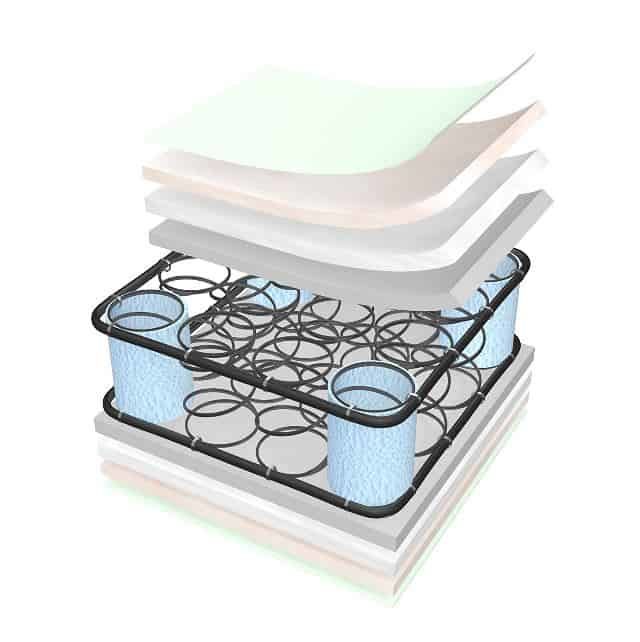
Nonetheless, picking the right side for yourself in the retention cream vs leap mattress debate could prove critical for a restful sleeping experience, one that rejuvenates your concrete structure, and alleviates (and prevents) dorsum-pain.
Conversely, brand the wrong pick, and you could end upwardly with a lot more than lost slumber – severe sciatica, short product lifespan, and a voided warranty are all on the table.
Memory Foam Mattress
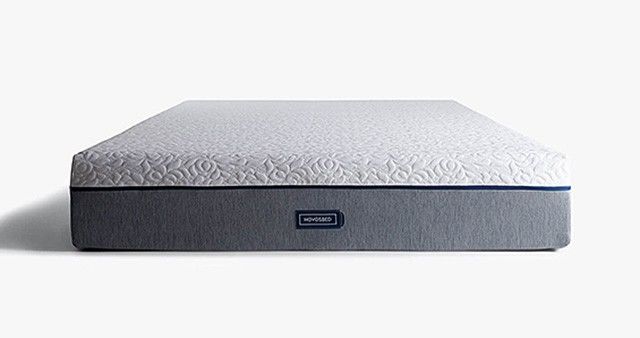
The Pros and Cons
Pros
- Shapes itself according to sleeper's body.
- Provides splendid support and pressure relief.
- Soft, enveloping feel.
- Isolates motion.
Cons
- Expensive.
- Tends to go hot.
- Temperature sensitivity may be a liability in extremes.
- Initial chemic odour.
Buy Now
The Basics of Memory Foam
Retention foam is known for its ability to adjust to the contours of the sleeper's trunk based on torso heat, which means it provides personalized pressure level indicate relief regardless of sleep manner – something that regular continuous / Bonnell coil leap mattresses but can't attain. The conformity results in superior spinal alignment that both relieves and prevents sciatic pain.
Yet, on its own, information technology is insufficient to make upwards an unabridged mattress – rather, it is used equally a comfort layer, with the base consisting of a more resilient support layer of loftier density polyurethane cream.
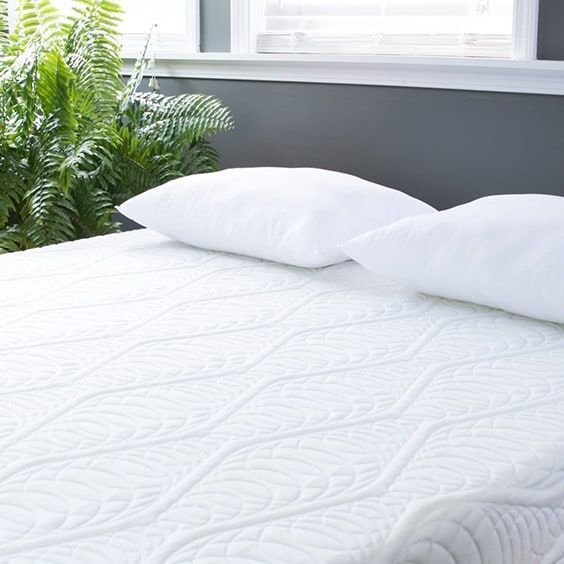
How long a memory foam mattress performs effectively depends on its density: high finish memory foam mattresses unremarkably have comfort layers comprising of more than 4 lb./cu.ft. dense memory foam, which enables them to remain useful for quite a long flow of time.
Back up
The support in these mattresses is dependent on both the comfort layer (made of retentiveness foam) and the support layer (made of polyfoam). The conforming nature of retentivity cream means it will compress differentially based on the parts of your body which are sticking out the most (take note, side sleepers). This in plough will enable you to maintain proper spinal alignment during your sleep – which is the crux of a mattress'due south support.
However, since memory foam molds itself according to body oestrus, and does non rebound any of the impact to you, it is regarded past some as 'dead' support – significant that you won't feel the same springy sensation as yous get from regular foam or latex.

The support layer is what handles the entire weight of your body, merely it is only effective if your body is able to sink through the peak layer and come up into observable contact with the support layer – in other words, also thick a layer of memory foam, and you may feel similar you're sleeping in a hammock – a certain recipe for back ache.
Comfort and Pressure level Relief
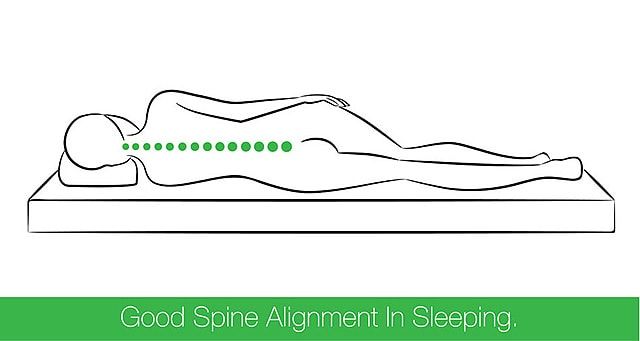
Its ability to mold itself to the body's contours enables memory foam to target the major pressure level points in the body i.e. the spine, the neck and the shoulders. It is able to shape itself according to how these are jutting out, and therefore able to alleviate the pressure they would normally exert in the instance of a non-responsive sleeping surface.
Annotation that it will experience more like y'all're sleeping 'in' the mattress as opposed 'on' it, considering of the deeper force per unit area relieving cradle formed by the sinking memory foam.
The quicksand like response of memory foam stems from its reaction to estrus, which alters its physical construction and causes it to compress according to the force per unit area information technology feels. While this allows for an unprecedented degree of personalized comfort, it can also create problems in temperature extremes:
Too cold, and the surface volition become difficult and unresponsive; also warm, and y'all may wake up hot and sweaty in the middle of the dark – the latter is specially true of showtime generation retentiveness foam, with its closed cell structure that doesn't allow for adequate air flow.
The problem has been rectified somewhat in mod retention foam products, through the application of open-prison cell technology and combination with cooling gel , that enable meliorate thermal ventilation.
Motion Transfer
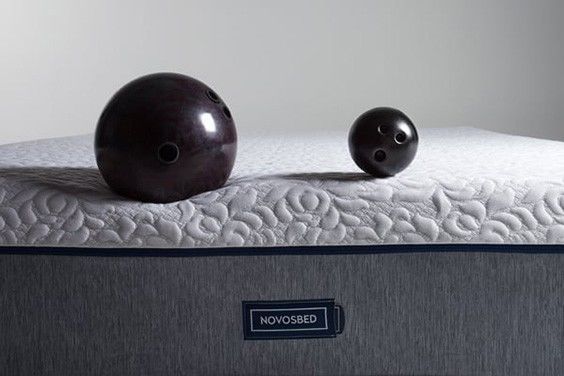
Retention cream's viscoelastic nature allows it to respond to force per unit area very locally, which translates into excellent move isolation, a very important consideration if you share your bed with a partner who tends to move a lot during the dark.
Durability
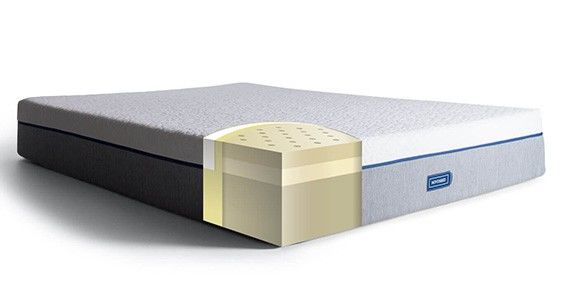
Every bit mentioned above, the durability of a retentivity cream mattress is direct related to its density – while iv lb./cu.ft. is the minimum you should aim for if you don't want to experience sag within the commencement year or so, nosotros recommend going for at least 5 lb./cu.ft. if y'all desire a product that volition final truly long.
Notation that fifty-fifty when memory cream does prove its age, it only gets softer as compared to most other materials which tend to settle into hard recesses – across a certain point, information technology will get as well soft and won't offer sufficient support to your body.
Maintenance
To get the most out of your retentiveness cream mattress, it is recommended that you lot rotate the head to the anxiety after three months to prevent the development of a lasting physical impression every bit the mattress gets older.
Since memory foam is temperature and humidity sensitive, you'll desire to use it in a room with a moderate, regulated temperature for it to acquit optimally. At lower temperatures, information technology could become firmer and more than decumbent to wear; if you received your new memory foam mattress folded at a sub-xl Fahrenheit temperature, do give it time to equalize with the environment – opening information technology by strength may result in damage.
Innerspring Mattress
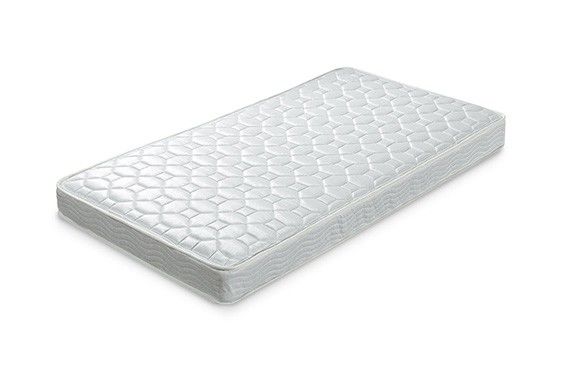
The Pros and Cons
Pros
- Bachelor for a wide range of budgets.
- Certain varieties offer befitting support.
- Springy, reactive experience.
- By and large inexpensive compared to memory foam.
Cons
- Mainstream varieties may lack sufficient support / pressure relief for dorsum ache patients.
- But the nigh expensive mattresses offering a degree of movement isolation.
The Basics of Innerspring Mattresses
Innerspring mattresses are the nigh pop amongst consumers: they're cheap, and have been extensively developed to cater to a wide range of consumer requirements over the years. They consist of metallic springs, either woven out of a single wire into an unbroken construction, or crafted individually and combined together using a lacing.
The compactness of an innerspring mattress is determined by the thickness of its coils (measured in gauges – the higher the gauge, the thinner the coil). Thinner coils are better able to shape themselves to your torso profile, but are too less firm. The firmness tin can also be modified by the shape, number of turns and height of the coil. Innersprings can by and large exist divided into Bonnell coils, continuous coils, starting time coils, and pocket coils.
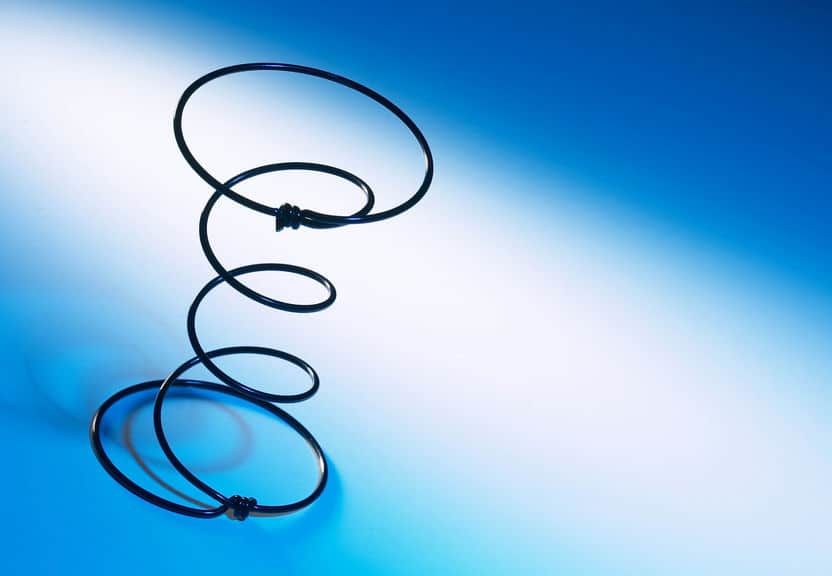
Bonnell Coils
These are helical shaped springs with a sparse centre part (that responds to soft force per unit area) that thickens towards the ends for overall support. Most inexpensive spring mattresses use this construction. Note that they are not even remotely close to memory cream in terms of comfort or support, and don't last more than than a few years, going by consumer reviews.
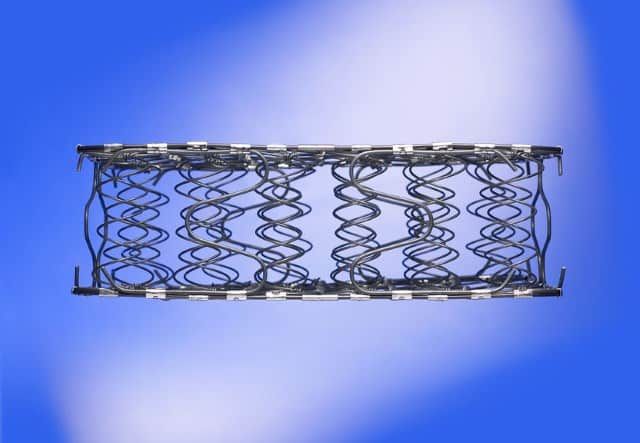
Continuous Coils
This spring system comprises of a single long wire twisted into hundreds of individual coils, linked together past a helical lacing. The lacing serves to isolate motion, and too improves the lifetime compared to Bonnell. Overall, continuous coils are more than supportive than Bonnell coils, but can't lucifer the contoured back up of memory foam.
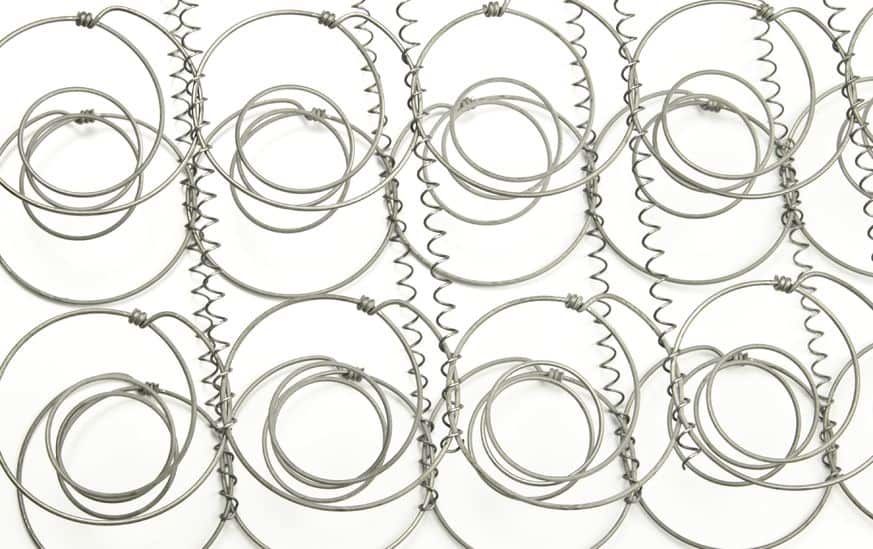
Offset Gyre
These are individual coils linked by helix shaped lacing – the individuality allows them to conform to your body so your musculo-skeletal structure tin can stay properly aligned while you sleep. They are quite stiff, and thus favored by some back anguish patients who desire some reactive forcefulness on their joints. Their construction makes them very durable besides, but they do suffer in the motility transfer reduction department.
Pocketed
These are soft, separately wrapped springs designed to provide conformity and back up on par with memory cream mattresses. The individualized wrapping of each coil also eliminates movement. These mattresses are pricier than standard bound configurations, only go on in listen that they won't automatically be more durable, since the independent springs are less hardy than a single unit.
In general, a mattress (with high quality individual springs) that has a higher curlicue count will be able to improve adjust to your physique – but this is simply part of the story. The leap types mentioned higher up are used exclusively in the back up layer of the mattress, so yous can't directly compare them to memory foam.
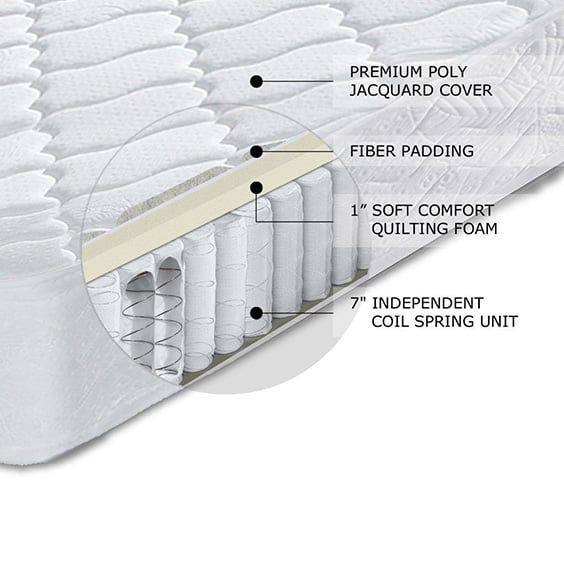
For that, we'll demand to look at microcoils: nowadays inside the condolement layer, they utilize thin and flexible metallic wires, and are used in a loftier coil count configuration. In conjunction with a thin layer of fiber or foam, microcoils are able to conform to your body similar to retentivity cream. Manifestly, mattresses that comprise them aren't as cheap every bit the ones which take more than standard innerspring compositions, merely are even so more affordable than high end memory foam options.
Support
All innersprings are able to offer springy, somewhat hard back up, with some being able to shape upwards to your actual contours upon initial compression, and and then providing the firm support upon further impression.
While regular mattresses using continuous coil and Bonnell coil structures yield minimal localized back up, the more advanced (and expensive) offset whorl and pocket roll models (especially those that have microcoils in the condolement layer) can provide a combination of springiness and conformity that works for back ache sufferers who aren't fans of the quicksand like feel of memory foam.
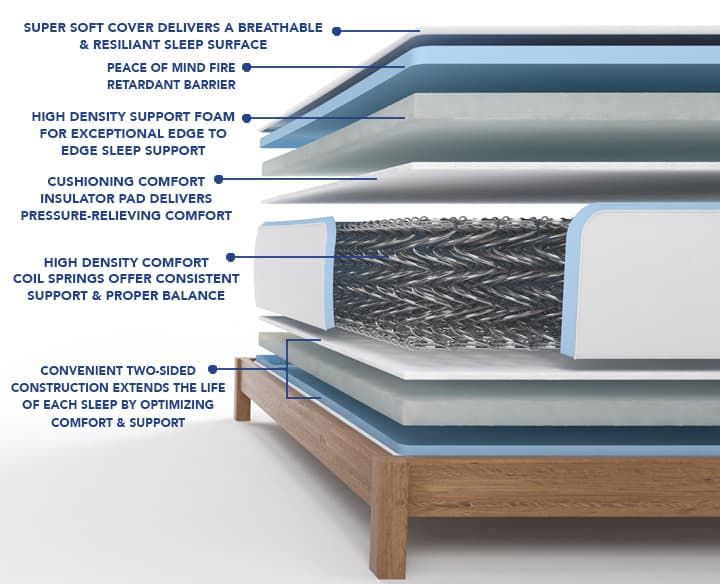
Obviously, as mentioned above, the thickness and quality of the steel used, the number and height of the coils, and the comfort fabric used, will all play a role in determining the overall support and firmness of the product.
Condolement and Pressure level Relief
Innersprings with continuous or Bonnell coil structures won't offer anything in terms of force per unit area relief (unless they're the more than expensive ones with pillowtops) – but a decent mattress with a pocketed base and micro-coils on top will offer force per unit area relief on par with skilful retentiveness cream options, sans the sinking sensation that some of usa are not fans of.
This is because individualized springs offer superior signal elasticity which allows them to course around your trunk – and then push button dorsum some of the force per unit area your trunk is exerting.
Heat Retention and Breathability
A mattress utilizing springs in its support core, and topped off by a polyfoam comfort layer (or microcoils) will not answer differently to unlike trunk temperatures, nor volition it retain any body rut.
However, certain manufacturers practise sell hybrid mattresses that employ springs as the base and memory cream as the comfort layer, and these products volition run hotter than typical innerspring offerings.
Durability
Spring mattress durability is primarily dictated past the quality of the material used in the coils, and the thickness thereof. Quite patently, coils with a larger bore and greater overall thickness, made from tempered steel, will concluding longer than cheap knockoffs.
In full general, innersprings are perhaps the toughest part of a mattress, and provided they are of good quality, will final longer than all secondary comfort and support materials it contains, except perhaps latex.
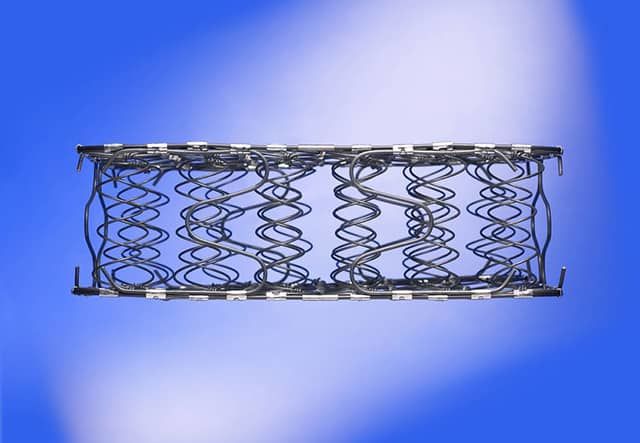
Maintenance
If you're using a double sided innerspring mattress, it is recommended that you flip and rotate it every three months or so, to reduce bodily impressions. For single sided mattresses, you lot need but rotate it after the aforementioned period. Other than that though, there isn't anything significant you lot demand to await out for.
purchase now
Firmness
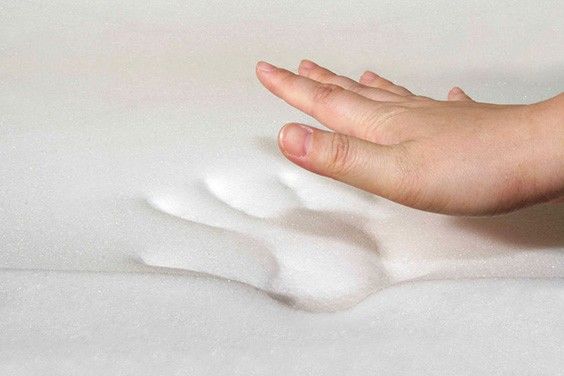
A straight comparison between the compactness of memory cream mattresses and bound mattresses isn't really possible, because the former is a soft material primarily designed for comfort / pressure relief with very fiddling touch on on the firmness of a mattress (unless information technology is appreciably deep, say 3", and with a higher compressive modulus), whereas the latter is an actual back up material that can impact the firmness of the concluding product.
In other words, you will take to compare betwixt the support layer of the retentiveness cream mattress, and the springs in the support cadre of the innerspring mattress, to gauge their deviation in firmness – and that is an entirely subjective thing.
Retention Cream Vs Pocket Coil Mattress
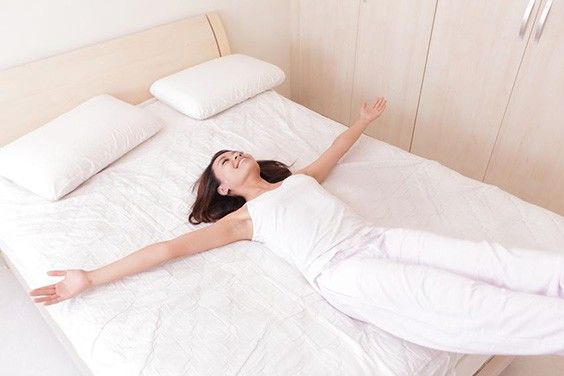
Pocketed coil mattresses deserve a defended comparing with memory foam, considering both tout themselves as being able to shape themselves according to the sleeper'due south physical construction, which translates into optimum spinal alignment and pain relief.
In terms of comfort and support, pocket ringlet mattresses are pretty much comparable to memory cream, merely they volition respond to pressure in a far more springier manner than the latter, which tends to absorb force per unit area as opposed to reflecting it (hence the 'sinking' feeling). In other words, if you adopt a more bouncy feel to your bed, you'll want to go with the pocket coil mattresses.
Retentiveness foam mattresses – even the most expensive ones – suffer from some degree of heat retention and initial chemical scent. If you're not a fan of this, pocket coil mattresses are a more affordable alternative you can resort to; the best of course, would be a natural latex mattress, only that is a little more pricey than an innerspring.
Memory Cream Vs Spring Mattress For Back Hurting

Equally we've discussed higher up, traditional innersprings with a continuous coil or Bonnell coil structure will not offering any conforming support, which is necessary for alleviating the stress from your pressure level points and maintaining proper spinal alignment during your sleep. This makes them unsuitable for sufferers of back pain.
The real comparison then, boils down to pocketed coil mattresses versus memory foam: and while both of them offer sufficient localized support and have the ability to adopt the shape of the sleeper'due south trunk, they vary in their surface feel.
Memory foam is soft and sinking, whereas pocketed curl mattresses are springy and reactive – so ultimately, it is a matter of what 'feels' right under your aching back.
Recommendations Based on Slumber Types
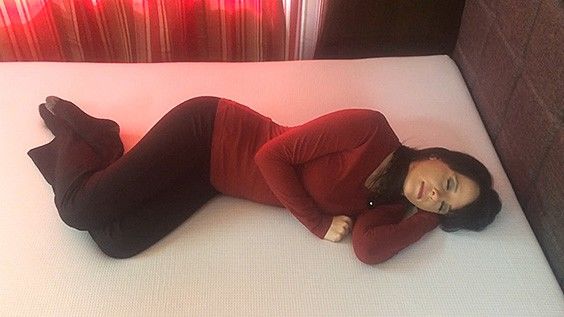
Side Sleeper
Side sleepers tend to exert the virtually stress on pressure level points i.eastward. hips and shoulder joints, and therefore crave a mattress that molds itself to these extruding body parts to keep their spine perfectly aligned as they slumber. This tin can be accomplished with memory foam mattresses, pocketed leap mattresses (even better with a comfort layer on top), and even retentiveness foam / innerspring hybrids.
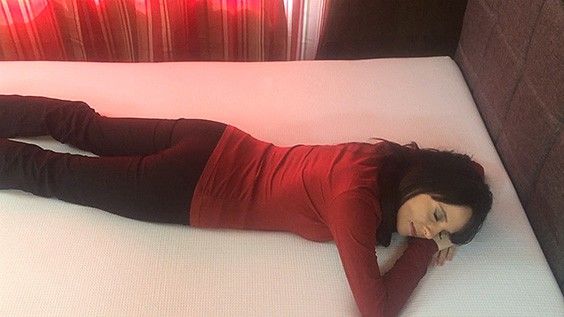
Breadbasket Sleeper
Stomach sleepers don't tend to exert a lot of forcefulness on their force per unit area points, so unless they're suffering from a specific condition that causes back pain, they can make practice with a regular innerspring mattress that offers minimal befitting back up.
Healthy females should take note though, regular innersprings may cause some inconvenience when you're sleeping in this position because they are unwieldy nether pressure, so an offset coil innerspring mattress (or even a pocketed ringlet one) may exist more than suitable.
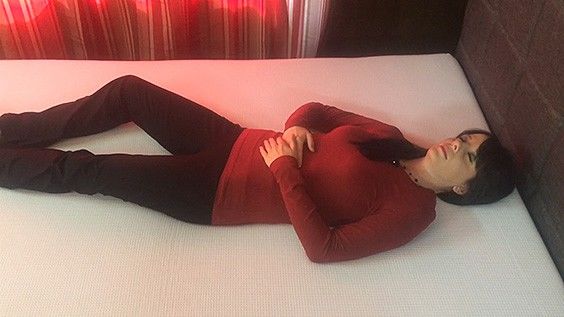
Back Sleeper
Dorsum sleepers' spines don't need much individualized support because they are already in their natural position (or pretty close), then again, if you sleep in this style, chances are you'll be simply fine with a decent continuous coil or Bonnell curl mattress.
Of course, if yous're dealing with back hurting (or have dealt with it before), a more befitting option such as an showtime scroll mattress might be a more advisable candidate.
Retentiveness Foam Mattress Vs Innerspring Mattress Comparison
| Memory Foam | Innerspring |
|---|---|
| Molds itself to contours of body | Some varieties are non-yielding, while others practice mold themselves |
| Provides individualized force per unit area relief | Merely some varieties provide individualized pressure relief |
| Fantabulous motion isolation | Only some varieties provide motion isolation |
| Temperature sensitive | Temperature agnostic |
| Sinking surface feel | Springy surface feel |
| Expensive | Relatively inexpensive |
| Used in comfort layer | Predominantly used in support cadre |
The Verdict
You lot may be expecting us to declare a visible winner in the retention foam vs innerspring mattress contend, merely if you've been paying attending to the comparisons above, it is impossible to name one.
Simply because the advantages of both kinds of mattresses are only relevant to consumers with specific requirements: retentivity foam mattresses are suited to chronic back pain sufferers looking for soft, befitting relief; bound mattresses are of many types – some are meant for budget buyers, while others provide personalized back up similar to retentiveness foam mattress just with a harder, springier feel.
And this is besides getting into details such as temperature sensitivity, motion transfer and maintenance. In other words, a lot of this volition come up down to personal preference and context – only hopefully, y'all're now equipped with enough knowledge about the strengths and drawbacks of both to make the right choice.
Source: https://www.thesleepjudge.com/memory-foam-vs-spring-mattress/
0 Response to "Reviews on Long Term Use of Foam Matressses Versus Coil Matresses"
Postar um comentário